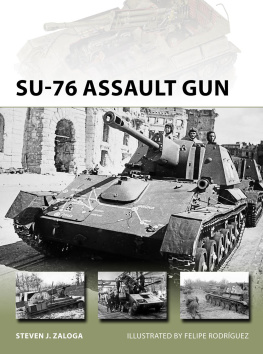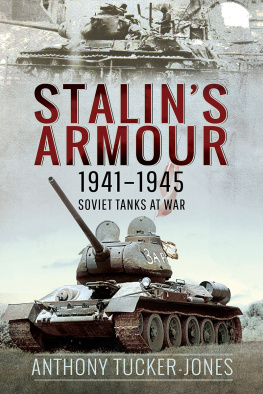ROUTLEDGE SERIES ON THE SOVIET STUDY OF WAR No.3
RED ARMOR COMBAT ORDERS
ROUTLEDGE SERIES ON THE SOVIET STUDY OF WAR
(Selected Translations)
Series Editor David M. Glantz
Ft. Leavenworth, Kansas
This series examines what Soviet military theorists and commanders have learned from the study of their own military operations. Separate volumes contain annotated translations of Soviet works analyzing their war experiences as well as the works of important Soviet military theorists and collections of Soviet articles concerning specific campaigns, operations, or military techniques.
1. Harold S. Orenstein, translator and editor, Soviet Documents on the Use of War Experience, Volume I, The Initial Period of War 1941 , with an Introduction by David M. Glantz
2. Harold S. Orenstein, translator and editor, Soviet Documents on the Use of War Experience, Volume II, The Winter Campaign 1941-1942, with an Introduction by David M. Glantz
3. Richard N. Armstrong, editor, Joseph Welsh, translator, Red Armor Combat Orders: Combat Regulations for Tank and Mechanized Forces, 1944, with an Introduction by Richard N. Armstrong
RED ARMOR COMBAT ORDERS
Combat Regulations for Tank and Mechanized Forces 1944
Edited with an Introduction by
Richard N. Armstrong
Translated from German by
Joseph G. Welsh
First published in 1991 in Great Britain by
Routledge
2 Park Square, Milton Park, Abingdon, Oxon, 0X14 4RN
270 Madison Ave, New York NY 10016
Transferred to Digital Printing 2007
Copyright 1991 Introduction Richard N. Armstrong Translation Joseph G. Welsh
British Library Cataloguing in Publication Data
Red armor combat orders: combat regulations for tank and mechanized forces 1944.
1. Union of soviet socialist Republics. Army combat vehicles. Tanks, History
I. Armstrong, Richard N.
623.74520947
ISBN 0-7146-3401-8
Library of Congress Cataloging in Publication Data
Soviet Union. Raboche-Krest ianskaia Krasnaia Armiia.
Red armor combat orders: combat regulations for tank and mechanized forces, 1944 / edited with an introduction by Richard N. Armstrong: translated from the German by Joseph G. Welsh.
p. cm.
Originally written in Russian and translated into the German by Reinhard Gehlen.
Includes bibliographical references.
I. Tank warfare. I. Armstrong, Richard N. (Richard Nolan), 1946
II. Welsh, Joseph G. III. Title.
UE159.S68 1991
358.18dc2091-9243
CIP
All rights reserved. No part of this publication may be reproduced in any form or by any means, electronic, mechanical, photocopying, recording or otherwise, without the prior permission of Routledge
Publisher's Note
The publisher has gone to great lengths to ensure the quality of this reprint but points out t h a t some imperfections in the original may be apparent
To Bonn and Lochlan who tolerate a student consumed in Soviet military history
RNA
To Anne mother, teacher, friend
JGW
Contents
Introduction
War came suddenly for the Soviet Union. The German invasion in June 1941 unleashed a horrific struggle on the eastern front at a scale and scope staggeringly higher than the battles on the Allies western front. The premier forces on both sides were the tank and mechanized forces, whose armored clashes at the tactical and operational levels determined the place, timing and outcome of major operations.
Despite the magnitude of fighting on the eastern front, much of the combat, including armored battles, remains obscure to Western readers. This clouded understanding, particularly of the role of the Red Army forces, is largely the result of a double language barrier, German and Russian, and of the guarded nature of Soviet military archival materials. The Red Armys Combat Regulations for Tank and Mechanized Forces come into the Wests hands through the German military files of the High Command of Forces, Foreign Armies East ( Fremde Heere Ost ). In September 1944, German military intelligence for the eastern front under the leadership of Colonel Reinhard Gehlen translated and distributed these and other Soviet regulations to the German Army. The Combat Regulations consist of two parts: Part I is applicable to company level and below; Part II, Brigade, Regiment, Battalion. Reproduced in this volume is Part II of these regulations.
Colonel Gehlens preface highlighted the significance of the document to German forces currently fighting the Red Army, stating: The regulation provides the latest guidance and combat principles for tank, mechanized and motorized rifle units of the Red Army by models and establishes a valuable foundation for the estimation of Soviet Russian armored branch of service.
The following thumbnail sketch of the Red Armys tank and mechanized forces development reviews past Soviet regulations and reveals the Combat Regulations applicability for understanding Soviet armored operations today.
Development of Soviet Tank and Mechanized Forces
The young Red Army emerged in 1920 from the Russian Civil War with a strong appreciation for the decisive role of maneuver that cavalry units offered on fronts with low troop density in the fight against the White Russians and their Western allies. In addition to large cavalry units, the Red Army employed armored car detachments along with armored trains and experimented with the use of World War I vintage tanks.
Rigorous Soviet postwar analysis of military operations in World War I and the Russian Civil War by Red Army military theoreticians provided the opportunity to compare operations and discern the accelerating impact of technology on contemporary warfare. Out of their theoretical works in the 1920s emerged military concepts captured, in part, by V.K. Triandafillovs writings, The Scope of Operations of Modern Armies (1926) and Character of Contemporary Military Operations (1929). These representative writings recognized the impact of the internal combustion engine on and the role of mechanized armies in future warfare. In short, Triandafillov called for the creation of powerful, highly mobile mechanized forces that could strike the entire depth of enemy dispositions.
On the practical side, the Soviet economy was in no shape to produce armored vehicles, or other military hardware for that matter, as envisioned in the Soviet militarys theoretical writings. Not until Stalin initiated Five-Year Economic Plans did Soviet industry begin to meet the challenge of such a military production requirement. Some military thinkers, who did not support the large-scale production of tanks, understood the limitations of light and heavy tanks, and recognized the technological lag in designing a good medium tank that combined an adequate balance of speed, firepower and armor protection. Nonetheless, despite being constrained by equipment and manpower, the Red Army in the late 1920s possessed the theoretical groundwork to realize a combat concept of deep operations centered upon a future Soviet tank and mechanized force.
By 1929, the Red Army under the practical guidance of the youthful, forward-thinking Marshal M. V. Tukhachevskii began experimentation with mechanized forces. In 1935 and 1936, the Red Armys use of mechanized forces culminated in major maneuvers employing corps size elements in the Kiev Military District. The maneuvers, as noted by one military writer, made it possible to work through problems related to conducting battle with the new formations. Regarding the maneuvers, V. N. Levichev, the Deputy Chief of Staff of the Workers and Peasants Red Army, noted:












